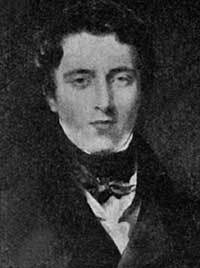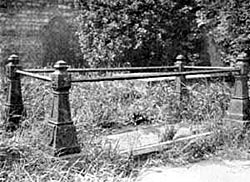< Previous | Contents | Next >
St James' Street and Mount Street
The premises near the junction of Granby Street and St. James's Street occupied by Messrs. Hardy are the original home of the Mechanics Institute and also (but this is disputed) of the Society which afterwards became the Derby Road Baptist Church.
Hidden away amongst the houses and yards on the south side of the street stands St. James's Street Chapel. Even if one knows where to look for it, it is very difficult to find, but it still stands there. Its foundation stone was laid in 1823 and it belonged to a Society of Independents who in after years migrated to the Park Hill Chapel on Derby Road.
That curious and rather unpleasant thoroughfare known as Thoroughfare Yard is of extreme antiquity for it is mentioned as early as 1315. When one remembers its convenience it is rather surprising that it has never developed into something more important than the grubby little footway which we now know.

Richard Parkes Bonnington (1802-1828).
There are many great names associated with St. James's Street, none of them perhaps so important as that of Richard Parkes Bonnington, the most marvellous artist that Nottingham ever produced. He lived in a house in St. James's Street after his father had removed from Arnold and before the family migrated to France, but as far as I know the house has never been identified. Then again Cornelius Launder, that mysterious High Sheriff of Nottingham whose name constantly occurs in Nottingham history but about whom so little is known, is said to have lived in St. James's Street in 1775, and in that same year St. James's Street was the scene of a most unfortunate riot of hosiery workers. The times appear to have been very difficult and a certain Mr. Huish was regarded as the leader of the hosiery employers a deputation consisting of a violent mob attempted to wait upon Mr. Huish at his house and explain their views upon the situation, but their explanation proved to be of such a nature that it was necessary to call in the military to answer it and eventually the mob were dispersed. The conduct of the military on this occasion calls forth one of Blackner's characteristic diatribes. Finally, there is a tradition that the original tombstone of Lawrence Collins does duty as a hearthstone for a house in St. James's Street, but whether this be true or not I have no means of knowing.
Mount Street was only so called about 1800. Its ancient name was Bearward Lane, reflecting the inhuman sport of bear baiting which was so popular right down to Puritan times. In this connection it is interesting to remember that we know that the name of the Nottingham bearward in 1577 was Ward and quite a little is known about his avocation.
Probably Mount Street derives its name from either Derry Mount or Windmill Hill and although there is nothing particularly pleasant in the street nowadays it is not without its memories of the past. In 1811 in a room up a yard off Mount Street were situated the premises of Chambers, Wilson and Morley, from which firm sprang the great hosiery firm of Messrs. I. & R. Morley who have done so much for the development of the hosiery industry throughout the world.
It is appropriate that the Lace Makers' Union should have their central office in Mount Street, for it was here that the lace machine had its birth. In 1775, Crane, of Edmonston, invented the warp machine and he sold the secret to Marsh for £100. Subsequently Joshua Tarratt of Mount Street developed it into the lace machine.
A business of quite a different character was carried on in Mount Street about the same time or a little earlier, for in 1749 William Hutton the well-known historian established himself as a bookseller in this street. Although extremely intellectual he does not seem to have been at all prosperous and in the course of his business he found it necessary to visit London with a certain frequency presumably to purchase stock. He was reduced to performing the journey on foot. This was an extremely hazardous proceeding as he experienced great dangers from footpads and highwaymen. He was wont to frustrate these gentry by carrying the bulk of his money sewn up in his shirt collar and other unlikely portions of his attire and carried a few odd coins in his pockets wherewith to satisfy his assailants should he fall into their hands. The street is also associated with the well-known Nottingham family Oldknow. In 1774 Oldknow was Mayor of Nottingham, and he must either have been extremely industrious or he must have neglected his duties as chief magistrate, for during his year of office he found time to lay siege to the heart of a lady in London with such assiduity that she capitulated and they were married during his year of office. This was looked upon as such a triumph by his contemporaries that upon his return to Nottingham after the ceremony he and his bride were conducted to their home in Mount Street by a civic procession.

Vason's tomb in the Baptist Chapel graveyard on Mount Street in the 1920s.
In a yard at the north side of Mount Street will be found the entrance to the old Baptist burial ground which was founded in 1724 immediately after the establishment of the Baptist Church in Friar Lane. It is a dreary enough place nowadays, it can be well seen from the premises of the Cripples' Guild in Park Row, but amongst its antiquated gravestones is one to the memory of George Vason whose life story is as romantic as anything that even Defoe conceived. He began life as a godly young man and his religious susceptibilities were such that he went out to the Friendly Isles as an artisan with a party of missionaries under the auspices of the London Missionary Society. For some time all went well, but as Vason was stationed at some distance away from his European confreres he gradually got into native habits until he had so far adopted the customs of the country as to forget his own tongue and to settle down practically as a chieftain amongst the savages by whom he was surrounded. He even went so far as to adopt polygamy and had two wives. He lived happily as the bosom friend of the local chief for some time, but a native war shook his position and he fell from his high estate and was subjected to all sorts of dangers. After a series of hairbreadth escapes, his account of which is most fascinating, he succeeded in making his escape and was carried by a chance ship to Canton, from whence he worked his passage as an ordinary seaman to New York and from thence he made his way back to Nottingham. As his story excited great interest and as he was without means of subsistence, Mr. Bailey resigned his office of town gaoler in his favour and he was established in the gaoler's house attached to the old Town Hall in Weekday Cross. He seems to have made an ideal gaoler and occupied that position from 1820 until his death in 1838. He was very much respected in the town and he was buried with much sorrow and honour in this burial ground which has now become little more than a cat run.
There is nothing particularly interesting about the upper end of Mount Street, which appears to have been completely remodelled about 1838.
